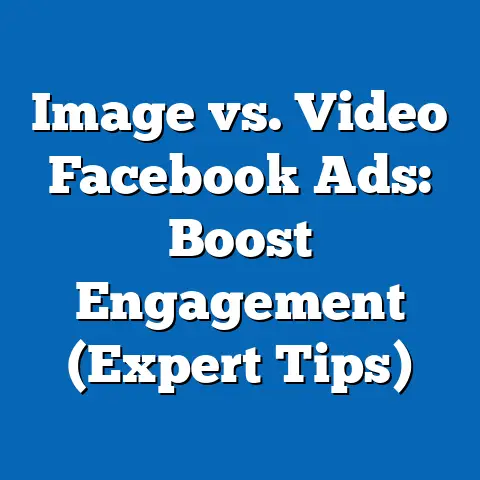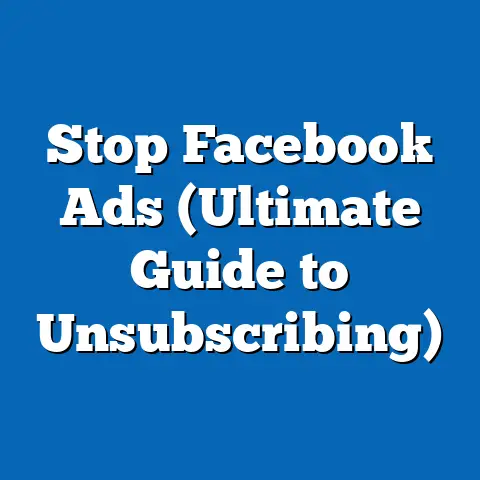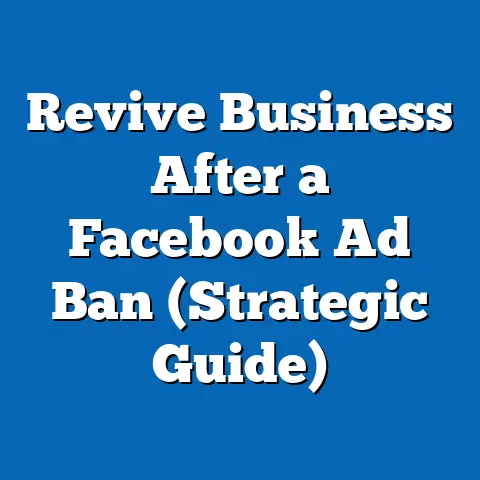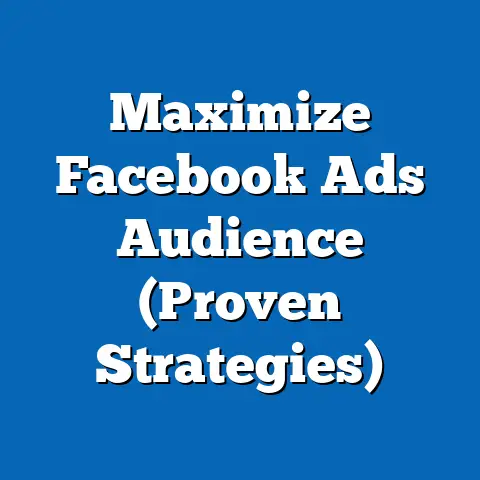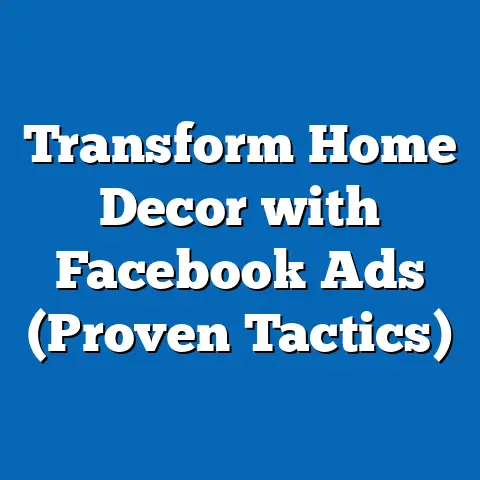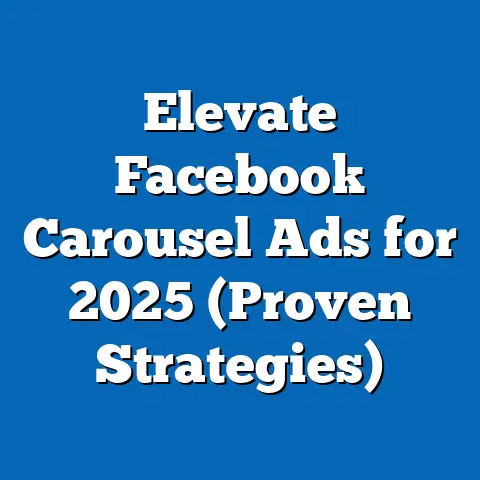Unlocking Facebook Lead Ads (Insider Strategies Revealed)
Imagine your marketing efforts as trying to navigate a world filled with allergens. You might be allergic to pollen, dust, or even certain foods. The frustrating part is, sometimes you don’t even know what’s causing the reaction until you’re already sneezing and itchy-eyed. Similarly, in the competitive world of digital marketing, especially with Facebook Lead Ads, the sources of success (or failure) can often be unexpected. Just like allergens can lurk in the most innocent-seeming places, highly effective advertising strategies can emerge from features or techniques you might have initially overlooked. Just as we must adapt to our allergies by seeking out solutions, marketers must continuously evolve their strategies to capture leads effectively.
That’s where Facebook Lead Ads come in. They offer a direct way to capture potential customer information without sending them off to a landing page. Think of them as a carefully designed “allergy test” for your audience, identifying those most receptive to your message. This article isn’t just about the basics; it’s about unlocking the insider strategies that can truly transform your lead generation game. Let’s dive deep and discover how to make Facebook Lead Ads a powerful tool for your business.
Understanding Facebook Lead Ads
Facebook Lead Ads are a specific type of ad format designed to collect information directly from users on the Facebook platform. Unlike traditional ads that drive traffic to an external landing page, Lead Ads keep users within the familiar Facebook environment. This is a huge advantage, especially on mobile, where loading times and clunky interfaces can kill conversions.
The core of a Lead Ad is the form that pops up when a user clicks on the ad. This form can be pre-populated with information Facebook already knows about the user (like their name, email, and location), making it incredibly easy for them to submit their details. This streamlined process dramatically reduces friction and increases the likelihood of someone becoming a lead.
Why are Lead Ads so important?
- Ease of Use: Setting up a Lead Ad is relatively straightforward, even for beginners. The guided interface in Facebook Ads Manager makes the process intuitive.
- Mobile-Friendly: Lead Ads are optimized for mobile devices, which is crucial considering the vast majority of Facebook users access the platform on their phones.
- Seamless Integration: Because the entire process happens within Facebook, users are less likely to abandon the form due to slow loading times or unfamiliar interfaces.
- Data Capture: You get valuable lead information directly, which can be integrated into your CRM or email marketing system.
I’ve personally seen businesses experience a significant drop in their cost per lead (CPL) simply by switching from traditional landing pages to Facebook Lead Ads. In one instance, a real estate client saw their CPL decrease by 40% after implementing Lead Ads, and the quality of leads actually improved because the process was so easy for potential buyers.
Statistics and Case Studies:
- Facebook themselves report that Lead Ads can generate leads at a significantly lower cost than traditional methods.
- Many case studies highlight the effectiveness of Lead Ads in various industries, from automotive to education, with companies reporting substantial increases in lead volume and conversion rates.
Takeaway: Facebook Lead Ads offer a streamlined, mobile-friendly way to capture leads directly on the platform. Their ease of use and seamless integration make them a powerful tool for businesses of all sizes.
Crafting Compelling Lead Forms
The lead form is the heart of your Lead Ad. A poorly designed form can be a major turnoff, leading to high abandonment rates and wasted ad spend. The key is to make the form as user-friendly and frictionless as possible.
Best Practices for High-Converting Lead Forms:
- Keep it Concise and Focused: Don’t ask for information you don’t absolutely need. The more fields you include, the lower your conversion rate will be. Focus on the essential details required to qualify and nurture the lead. For example, if you’re selling a high-end product, you might want to include a question about their budget range.
- Utilize Custom Questions: Custom questions allow you to gather specific information that helps you qualify leads and personalize your follow-up. Use multiple-choice questions, short answers, or conditional logic to tailor the experience to each user. I once worked with a financial advisor who used custom questions to determine a prospect’s investment goals and risk tolerance. This allowed them to immediately segment leads and provide personalized advice, resulting in a much higher close rate.
- Integrate Privacy Policies and Trust Signals: Reassure users that their information is safe and will be handled responsibly. Clearly display your privacy policy and use trust signals like testimonials or security badges to build confidence.
- Consider Form Length Based on Offer Value: If you’re offering something highly valuable (like a free consultation or a substantial discount), users will be more willing to provide more information. However, for simpler offers (like a newsletter signup), keep the form extremely short and sweet.
- Use Progress Indicators: If your form has multiple steps, use a progress bar to show users how far they are from completion. This can help reduce abandonment rates.
Examples of High-Converting Lead Forms:
- Simple Newsletter Signup: Name, Email
- Free Consultation: Name, Email, Phone Number, Brief Description of Needs
- Product Demo Request: Name, Email, Company Name, Job Title, Number of Employees
- Event Registration: Name, Email, Dietary Restrictions, Job Title
Analyzing What Makes Them Successful:
- Relevance: The questions are directly relevant to the offer.
- Clarity: The questions are easy to understand and answer.
- Brevity: The form is as short as possible while still gathering essential information.
- Trust: The form includes privacy policies and trust signals.
Takeaway: A well-designed lead form is crucial for maximizing conversion rates. Keep it concise, focused, and user-friendly, and always prioritize privacy and trust.
Targeting the Right Audience
Even the most compelling lead form won’t generate results if it’s shown to the wrong people. Effective audience targeting is essential for maximizing the effectiveness of Facebook Lead Ads. Facebook offers a wide range of targeting options, allowing you to reach specific demographics, interests, and behaviors.
Facebook’s Targeting Options:
- Demographics: Target users based on age, gender, location, education, job title, and more.
- Interests: Reach users who have expressed interest in specific topics, products, or services. This is based on their Facebook activity, like the pages they’ve liked and the content they’ve engaged with.
- Behaviors: Target users based on their online and offline behaviors, such as purchase history, travel habits, and device usage.
- Custom Audiences: Create custom audiences based on your existing customer data, such as email lists or website visitors. This allows you to retarget people who have already interacted with your business.
- Lookalike Audiences: Expand your reach by creating lookalike audiences based on your existing customers. Facebook will identify users who share similar characteristics and behaviors with your best customers.
Advanced Targeting Techniques:
- Layering Targeting Options: Combine multiple targeting options to create highly specific audiences. For example, you could target women aged 25-35 who are interested in fitness and have recently purchased athletic apparel online.
- Excluding Audiences: Exclude audiences who are not relevant to your offer. For example, if you’re promoting a product for new customers, you might want to exclude your existing customer base.
- Retargeting: Retarget users who have visited your website or interacted with your previous ads. This is a highly effective way to re-engage potential customers who have already shown interest in your business.
- Lookalike Audiences based on High-Value Customers: Instead of creating lookalike audiences based on all your customers, focus on your high-value customers. This will help you reach people who are more likely to convert into paying customers.
I remember working with an e-commerce client who was struggling to generate sales. We decided to focus on creating highly targeted audiences based on their customer data. We uploaded their email list to Facebook and created lookalike audiences based on their top 10% of customers. This resulted in a significant increase in their conversion rate and a substantial improvement in their ROI.
Takeaway: Effective audience targeting is crucial for maximizing the effectiveness of Facebook Lead Ads. Use Facebook’s targeting options to reach the right people with the right message, and don’t be afraid to experiment with advanced targeting techniques.
Crafting Irresistible Offers
A compelling offer is the bait that lures potential customers into your lead form. It’s what motivates them to take the time to provide their information. The key is to understand your target audience and create offers that are genuinely valuable and relevant to their needs.
The Psychology Behind Compelling Offers:
- Value: The offer must provide tangible value to the user. This could be a discount, a free trial, exclusive content, or access to a valuable resource.
- Relevance: The offer must be relevant to the user’s interests and needs. A generic offer is less likely to be effective than an offer that is tailored to a specific audience.
- Scarcity: Creating a sense of scarcity can increase the perceived value of the offer. For example, you could offer a limited-time discount or a limited number of free trials.
- Urgency: Adding a sense of urgency can motivate users to take action immediately. For example, you could offer a discount that expires in 24 hours.
Examples of Successful Offers:
- Free Trials: Offer a free trial of your product or service. This allows potential customers to experience the value firsthand before committing to a purchase.
- Discounts: Offer a discount on your product or service. This can be a great way to incentivize people to become leads and make a purchase.
- Exclusive Content: Offer access to exclusive content, such as e-books, webinars, or white papers. This can be a great way to attract potential customers who are interested in learning more about your industry.
- Free Consultations: Offer a free consultation with an expert. This can be a great way to build trust and establish a relationship with potential customers.
- Contests and Giveaways: Host a contest or giveaway. This can be a great way to generate leads and increase brand awareness.
Testing and Optimizing Offers:
- A/B Testing: Test different offers to see which ones perform best. This could involve testing different headlines, images, or call-to-action phrases.
- Tracking Conversion Rates: Track the conversion rates of your different offers to see which ones are most effective.
- Analyzing User Feedback: Analyze user feedback to understand why certain offers are performing better than others.
I had a client in the software industry who was struggling to generate leads. We decided to test different offers, including a free trial, a discount, and access to exclusive content. We found that the exclusive content offer (a detailed e-book) performed the best, generating significantly more leads than the other offers. This taught us that their target audience was more interested in learning about the industry than simply getting a discount.
Takeaway: A compelling offer is essential for attracting potential customers and generating leads. Understand your target audience and create offers that are genuinely valuable and relevant to their needs. Don’t be afraid to test different offers to see which ones perform best.
Leveraging Creative Assets
While the form and the offer are crucial, don’t underestimate the power of visual appeal. Your creative assets – images and videos – are the first thing users see, and they play a huge role in grabbing attention and driving clicks.
The Importance of Visuals:
- Attention-Grabbing: Eye-catching visuals can help your ad stand out from the crowd.
- Storytelling: Visuals can tell a story and connect with your audience on an emotional level.
- Brand Building: Consistent visuals can help build brand recognition and awareness.
- Clarity: Visuals can help explain complex concepts in a simple and engaging way.
Best Practices for Designing Effective Visuals:
- Use High-Quality Images and Videos: Avoid using blurry or pixelated images.
- Keep it Simple and Clean: Don’t clutter your visuals with too much text or graphics.
- Use Bright and Contrasting Colors: This will help your ad stand out in the Facebook newsfeed.
- Showcase Your Product or Service: If you’re promoting a product, show it in action.
- Use Emotionally Evocative Imagery: Connect with your audience on an emotional level.
- Test Different Visuals: A/B test different images and videos to see which ones perform best.
The Role of Ad Copy:
- Headlines: Your headline is the first thing people will read, so make it compelling and attention-grabbing.
- Body Text: Use the body text to explain the benefits of your offer and encourage users to take action.
- Call-to-Action (CTA): Your CTA should be clear, concise, and action-oriented. Use phrases like “Learn More,” “Sign Up Now,” or “Get Your Free Trial.”
I’ve seen ads with mediocre offers perform exceptionally well simply because the visuals were stunning and the copy was persuasive. Conversely, I’ve seen ads with great offers flop because the visuals were unappealing and the copy was bland.
Takeaway: Visuals are a crucial part of your Facebook Lead Ads. Use high-quality images and videos that are relevant to your offer and target audience. Craft compelling ad copy that grabs attention and encourages users to take action.
Analyzing and Optimizing Lead Ad Performance
Launching your Lead Ad is just the first step. The real magic happens when you start analyzing the data and optimizing your campaign for better results. Facebook Ads Manager provides a wealth of information that can help you understand how your ads are performing.
Key Performance Metrics (KPIs) to Track:
- Cost Per Lead (CPL): This is the average cost you pay for each lead.
- Conversion Rate: This is the percentage of people who click on your ad and submit the lead form.
- Engagement Rate: This measures how people are interacting with your ad, including likes, comments, and shares.
- Click-Through Rate (CTR): This is the percentage of people who see your ad and click on it.
- Reach: This is the number of people who saw your ad.
- Frequency: This is the average number of times each person saw your ad.
Using Facebook Ads Manager for Analysis:
- Create Custom Reports: Customize your reports to focus on the metrics that are most important to you.
- Analyze Audience Performance: See which audiences are performing best and adjust your targeting accordingly.
- Track Ad Creative Performance: See which images and videos are generating the most clicks and conversions.
- Monitor Placement Performance: See which placements (e.g., Facebook newsfeed, Instagram feed) are performing best.
Methods for Data-Driven Decisions:
- A/B Testing: Continuously test different elements of your ad to see what works best.
- Audience Segmentation: Segment your audience based on demographics, interests, and behaviors, and tailor your ads accordingly.
- Budget Optimization: Allocate your budget to the ads and audiences that are performing best.
- Landing Page Optimization: If you’re using landing pages in conjunction with your Lead Ads, optimize them for conversion.
I always tell my clients that Facebook advertising is an ongoing process of testing, analyzing, and optimizing. You can’t just set it and forget it. You need to continuously monitor your performance and make adjustments as needed.
Takeaway: Data analysis is essential for refining your Facebook Lead Ads and maximizing your ROI. Track key performance metrics, use Facebook Ads Manager to analyze your performance, and make data-driven decisions for future campaigns.
Conclusion
Facebook Lead Ads are a powerful tool for businesses looking to generate high-quality leads and grow their customer base. By understanding the intricacies of Lead Ads, crafting compelling lead forms, targeting the right audience, creating irresistible offers, leveraging creative assets, and analyzing performance, you can unlock the full potential of your Facebook advertising efforts.
Remember, the key is to continuously test, analyze, and optimize your campaigns. The strategies outlined in this article are just a starting point. The more you experiment and learn, the better you’ll become at generating leads with Facebook Lead Ads. So, go ahead, implement these insider strategies and watch your lead generation soar!

